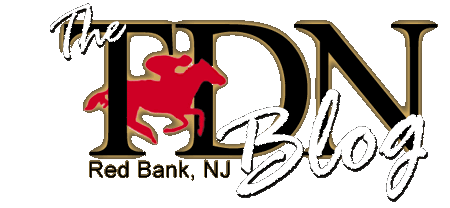--Kelsey Riley
This past weekend I had the pleasure of attending the races at Punchestown, the premier national hunt (jumps) race meet in Ireland. Despite the ominous threat of rain that had persisted in the Emerald Isle all week, I eagerly pulled on my boots and coat and headed out to the water logged course. I was eager to take in my first live jumps meeting, and I was far from disappointed.
This past weekend I had the pleasure of attending the races at Punchestown, the premier national hunt (jumps) race meet in Ireland. Despite the ominous threat of rain that had persisted in the Emerald Isle all week, I eagerly pulled on my boots and coat and headed out to the water logged course. I was eager to take in my first live jumps meeting, and I was far from disappointed.
Before delving into the story of the Punchestown meet, it is
important to note the prominence of national hunt racing in Ireland. While
jumps racing in America is a rare commodity and takes a notable backseat to the
flat, the opposite is true in Ireland, at least as far as race goers are
concerned. In 2011, almost double the amount of people attended a national hunt
meet than a flat racing meet. The number of people in attendance at Ireland’s
biggest flat racing festivals exceeded regular national hunt meeting crowds by
just 2 per cent.
 |
| Busy bookies at Punchestown |
Prior to attending Punchestown, I struggled to understand
this trend. My experience as a spectator of national hunt was limited to the
Grand National, and based on that meeting, I was far from impressed: I battled
to find enjoyment in watching horses fall over almost every fence, and two
breakdowns in one race was too many. I couldn’t understand why these people
enjoyed this sector of racing so much. Perhaps it was just an Irish thing.
I headed to Punchestown with the hope of being convinced
otherwise, and happily I was. I quickly came to understand why this fixture is
so popular over here: with races over two and three miles, spectators have much
longer to enjoy the race than they typically do on the flat. Throw in a few
obstacles (jumps, ditches, and hills), and the action gets a little more
exciting. As one of my Irish colleagues pointed out, national hunt racing has a
lot to offer bettors as well. In such long races with so many different
dynamics, if a horse has a bad start or is affected in some way, there is great
opportunity to turn his fortunes around. If the same thing were to happen in a
five furlong sprint on the dirt, it would probably be a different story.
 |
| Racing past the stands |
The constitution of the national hunt horse predisposes it
to drawing a loyal fan base. These horses typically don’t start racing until
their later years (there was a ‘juvenile’ race on the card for four-year-olds),
which, depending on your opinion, may or may not contribute to longevity and
soundness. The average age of the horses on this particular card was about 9
years, and one was 15. And while one may think racing 3-plus miles over jumps
may be taxing on these horses, the winners of the first two races on the card
were making their second starts at the Punchestown carnival (which is only five
days long).
 |
| Over the final fence |
While some national hunt horses are former flat racers,
there is a thoroughbred breeding sector in Ireland devoted to producing jumps
horses. Typically, stallions that didn’t earn their keep siring flat horses are
reverted to the national hunt ranks. Nonetheless, the G1 AES Champion Hurdle
for four-year-olds boasted the progeny of such distinguished stallions as
Dalakhani, Montjeu, King’s Best, High Chaparral, and Hurricane Run. The winner,
Hisaabaat, was a gelded son of arguably the world’s current hottest sire,
Dubawi. Hisaabaat had cost 140,000 Euros as a yearling in Ireland. After
recording a win and two placings from six starts on the flat, trainer Dermot
Weld reverted his charge to the national hunt realms. After unseating his rider
in his first jumps try in December, Hisaabaat has hardly missed a beat,
finishing first or second in all six starts since. I guess it goes to show, as
in all forms of racing, that anything can happen.
To make a long story short, I quite enjoyed my day out at
Punchestown. It also helped that only one horse fell, and it was unscathed.
After experiencing some doubts about this sector of the sport, I was quickly converted into a fan.
A taste of Punchestown action
-- Kelsey Riley is a second year trainee on the Darley Flying Start program. She will join the TDN staff in July.


No comments:
Post a Comment